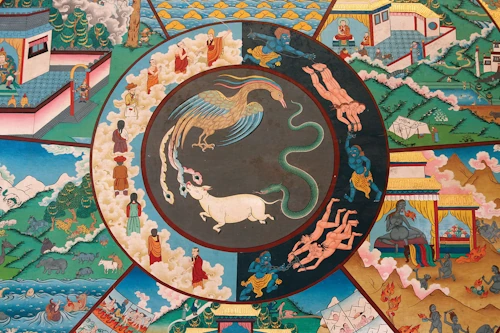In the pursuit of spiritual freedom, the concept of Moksha stands as a beacon of liberation from the endless cycle of rebirth and death, known as samsara (or reincarnation). Rooted in the ancient traditions of Hinduism, Buddhism, Jainism, and Sikhism, Moksha embodies the quintessence of emancipation, where the soul transcends the illusions of duality, achieving a state of pure consciousness and awakening. This ultimate aim is not just the cessation of physical existence but an awakening to the profound reality beyond the Veil of Maya, realizing the unity of the universe and the self.

The journey towards Moksha is intertwined with the practices of self-realization, awareness, and the dissolution of attachment and ignorance that bind the soul to the material world. In this detailed exploration, we will compare Moksha with its counterpart in Buddhism, Nirvana, and unveil the various pathways that lead seekers to this pristine state of liberation. Through the lens of Dharma, Artha, and Kama, we shall decode how these life objectives complement the quest for spiritual freedom, navigating through modern interpretations and the unique challenges presented in the digital era.
The Historical Context of Moksha
Moksha, derived from the Sanskrit root ‘muc’, signifies the act of liberation, encompassing the notions of freeing, releasing, or letting go. This concept is pivotal in Hinduism, where it represents the ultimate goal of human existence—salvation or liberation from the cycle of birth and death (or reincarnation), known as samsara. The emergence of Moksha as a spiritual goal dates back to the 1st millennium BCE during a period of profound religious development along the Ganges River valley in India. This era witnessed the rise of new religious movements that advocated the idea of life as a state of bondage to a continuous cycle of rebirth, urging the pursuit of spiritual liberation.
In philosophical terms, Moksha is closely intertwined with the dualistic theories of the Samkhya school of Hinduism, which posits the existence of two eternal realities: prakriti (matter) and purusha (consciousness). Liberation, or kaivalya, is achieved when an individual’s consciousness recognizes its complete separateness from material existence. This realization frees the soul from the bindings of worldly existence and leads to celestial emancipation. The Vedantic school further elaborates on Moksha by dividing it into two stages: Jivanmukti, liberation achieved during one’s lifetime, and Videhamukti, liberation attained after death.
The broader implications of Moksha extend beyond mere freedom from physical rebirth. It encompasses an epistemological and psychological liberation from ignorance, culminating in self-realization, self-actualization, and self-knowledge. This state is not only about the absence of suffering but is characterized by a profound experience of oneness with Brahman, the supreme self, manifesting as knowledge, peace, and bliss. The concept transcends the boundaries of Hinduism, finding resonance in other spiritual traditions like Buddhism, Jainism, and Sikhism, where it is referred to by various names such as vimoksha, vimukti, and mukti, each emphasizing a nuanced understanding of spiritual release and enlightenment.
Moksha vs. Nirvana: Understanding the Differences
In exploring the spiritual concepts of Moksha and Nirvana, it is crucial to understand their unique characteristics and the philosophical foundations they rest upon. Moksha, primarily rooted in Hinduism, is the liberation of the soul from the cycle of birth and death, often visualized as the soul’s union with Brahman, the ultimate reality. This liberation is not merely an escape from physical existence but a deep realization of one’s true self, achieved through various paths like devotion (Bhakti), knowledge (Jnana), and righteous action (Karma).
Conversely, Nirvana is a central concept in Buddhism, representing the ultimate state of being free from all worldly suffering and the continuous cycle of rebirth. This state is achieved through enlightenment, which involves a profound understanding of the truths of existence, culminating in the cessation of desires and attachment. Unlike Moksha, where the soul merges with a universal consciousness, Nirvana is characterized by the realization of Anatta (non-self) and Sunyata (emptiness), highlighting a fundamental absence of a permanent soul or self.
The paths to these states also reflect their doctrinal differences. While Moksha can be approached through multiple disciplines reflecting the diverse practices within Hinduism and also Jainism’s Anekantavada (many-sided reality), Nirvana is primarily attained through the disciplined practice of the Eightfold Path, which includes Right View, Right Resolve, Right Speech, Right Action, Right Livelihood, Right Effort, Right Mindfulness and Right Concentration. This disciplined approach emphasizes moral conduct, meditation, and wisdom as essential components in breaking free from suffering and illusion.
By recognizing these distinctions and the varied interpretations across different schools of thought, one gains a clearer view of how these otherworldly goals shape the pursuit of ultimate liberation and enlightenment in their respective traditions.
The Four Paths to Moksha
In the pursuit of Moksha, or spiritual liberation, Hindu philosophy outlines four distinct paths that cater to different aspects of human nature and spiritual inclination. Each path offers a unique approach to achieving the ultimate goal of liberation from the cycle of birth and rebirth, known as samsara.

Karma Yoga: The Path of Selfless Action
Karma Yoga emphasizes actions performed without any attachment to outcomes or rewards. This path teaches the importance of duty while maintaining a state of mental detachment from the results. Practitioners focus on their responsibilities and actions as a form of worship, and through this selfless service, they aim to purify their hearts and dissolve the ego, which is essential for attaining liberation.
Bhakti Yoga: The Path of Devotion
Bhakti Yoga is centered around deep devotion and love towards a personal deity or the divine essence. This path involves engaging in various practices such as singing hymns, chanting, and participating in rituals, all aimed at fostering a profound emotional connection with the divine. Through this loving devotion, followers seek to transcend the self and merge with the divine, leading to spiritual freedom.
Rāja Yoga: The Path of Meditation
Also known as the “royal path,” Rāja Yoga involves a comprehensive methodology that includes ethical disciplines, physical postures, breathing control, and meditation. This path is designed to gradually bring the mind under control, enabling deep meditation and eventually leading to samadhi, the highest state of mental concentration where the individual self merges with the universal consciousness.
Jñāna Yoga: The Path of Knowledge
Jñāna Yoga is the pursuit of wisdom and intellectual discernment. It involves deep study and contemplation of philosophical texts, coupled with intense meditation. Practitioners strive to discern the real from the unreal, ultimately gaining the knowledge of the self’s true nature, which is believed to be identical with the absolute reality, leading to liberation.
Each of these paths can be pursued independently or in combination, depending on an individual’s temperament and life circumstances. They all converge to the same ultimate goal of Moksha, providing a diverse yet unified approach to spiritual liberation.
The Role of Dharma, Artha, and Kama in Attaining Moksha
In Hindu philosophy, the concepts of Dharma, Artha, and Kama play integral roles in shaping a balanced life that ultimately leads to Moksha, the liberation from the cycle of birth and rebirth. Dharma, representing righteous living, is the moral foundation that supports both personal and societal well-being. It involves adhering to ethical principles that ensure actions, words, and thoughts contribute positively to the harmony and order of society. This adherence not only fosters personal growth but also aligns one’s actions with the universal truths and duties designated for each stage of life.
Artha, the pursuit of material prosperity, is recognized as a necessary aspect of life that provides security and comfort. However, it is emphasized that Artha should be sought without compromising Dharma. Ethical accumulation and utilization of wealth reflect a higher consciousness that respects societal welfare and supports communal harmony. By integrating Artha with Dharma, individuals can enjoy material success while contributing to the social fabric, ensuring that prosperity serves a higher purpose beyond mere personal gain.
Kama, which encompasses the pursuit of pleasure and emotional fulfillment, is also seen as essential for a well-rounded life. However, it is crucial that Kama is pursued mindfully, ensuring that the quest for pleasure does not overshadow the otherworldly goals or disrupt the moral and ethical duties outlined by Dharma. By balancing sensual pleasures with spiritual duties and material goals, individuals can lead a fulfilling life without losing sight of the ultimate aim of achieving Moksha—a state of complete liberation and self-realization. This balanced approach allows for a holistic development, integrating all aspects of human life towards the attainment of spiritual freedom.
Modern Interpretations and Practices Leading to Moksha
In contemporary times, the pursuit of Moksha has adapted to integrate both traditional and modern methodologies, reflecting its timeless relevance in achieving spiritual liberation. This spiritual quest is increasingly viewed through the lens of personal development and psychological well-being, emphasizing its profound impact on mental health.
- Holistic Well-being and Mental Health: The traditional goal of Moksha is now frequently discussed in the context of holistic health practices. It is recognized not only as a spiritual achievement but also as a powerful framework for mental health. Practices derived from the principles of Moksha, such as meditation and yoga, are scientifically validated for their benefits in reducing stress, anxiety, and depression, enhancing overall emotional and psychological resilience.
- Integration with Modern Psychology: The principles underlying Moksha are finding their place in the field of Indian psychology, which melds age-old spiritual insights with contemporary psychological practices. This integration helps individuals on their path to self-actualization, a concept closely linked to Moksha. Self-actualization refers to the realization of one’s full potential and is seen as the pinnacle of personal development. By fostering an understanding of the self’s true nature and its unity with the universe, the teachings of Moksha encourage a profound personal transformation.
- Community and Societal Harmony: Beyond individual benefits, the modern interpretation of Moksha also underscores its societal implications. A community that embraces the values of Moksha—compassion, detachment from materialism, and a focus on spiritual growth—tends to promote greater social harmony and empathy among its members. This collective spiritual awareness can lead to more peaceful coexistence and a heightened sense of communal responsibility.

These contemporary approaches to Moksha demonstrate its enduring appeal and adaptability, proving that ancient wisdom can effectively address modern challenges and contribute significantly to both personal and societal well-being.
Moksha in the Digital Age: Challenges and Opportunities
In the digital era, the quest for Moksha —or spiritual liberation— encounters unique challenges and opportunities. The accessibility of vast amounts of information and digital tools can both aid and complicate the path to enlightenment. Platforms such as YouTube, blogs, and social media offer unprecedented access to spiritual teachings and practices, which can be instrumental in spreading awareness and facilitating the journey towards liberation. However, the sheer volume of available content also raises concerns about the accuracy and authenticity of the information, which can lead to misinformation and misinterpretation of critical otherworldly concepts.
Digital resources like meditation apps and online yoga classes have become invaluable tools for many seeking to incorporate spiritual practices into their daily lives. Reports indicate that 78% of users have experienced an improvement in their spiritual well-being through these digital means. Furthermore, the reach of spiritual leaders has expanded, with 65% noting an increase in followers via digital platforms. These tools not only provide practical methods for practicing mindfulness and meditation but also create communities where individuals can share experiences and support each other’s spiritual growth.
Despite these advantages, there is a significant risk of trivializing the profound concept of Moksha, reducing its transformative impact. The convenience of digital access might lead some to treat these ancient teachings as quick solutions rather than profound life commitments. Additionally, the distraction of constant connectivity can hinder the deep introspection required for true spiritual progress. Balancing the use of digital tools with traditional practices and ensuring the authenticity of the teachings are crucial for maintaining the integrity and depth of the spiritual journey towards Moksha in this modern age.
Conclusion
Throughout this exploration of the pursuit of spiritual emancipation, we’ve traversed through the vast terrains of Moksha and its counterparts in various traditions, unraveling the essence and pathways that guide souls to the pinnacle of self-awareness and liberation from cyclic existence. We’ve delved into the principles of Dharma, Artha, and Kama, illuminating how these foundational concepts intertwine to steer individuals towards the ultimate freedom of Moksha. By comparing and contrasting Moksha with Nirvana, we’ve broadened our understanding of liberation, highlighting the diverse yet interconnected ways through which spiritual awakening is sought and realized across different philosophies.
In the digital age, the quest for spiritual liberation faces new challenges and opportunities, yet the ancient wisdom of Moksha remains as relevant as ever, offering profound insights and practical methodologies for transcendence and self-realization. As we harness technology to explore and expand our divine journey, let us remain vigilant of the essence of these teachings, striving for authenticity and depth in our pursuit. The paths to Moksha, be it through selfless action, devotion, disciplined meditation, or the pursuit of wisdom, invite us to transcend the mundane, beckoning towards a state of oneness with the universe. This journey not only promises liberation from the cycle of reincarnation, but also fosters a life of harmony, understanding, and blissful peace, echoing through our existence and beyond.
So, what is the best method to tell if you are walking the path of spiritual liberation? For example, performing our awareness and awakening tests. The results will give you an idea of your level of consciousness and attachment (or detachment) to the material world.
TAKE THE AWARENESS TEST
TAKE THE AWAKENING TEST
TAKE THE GREAT PERSONALITY TEST
MINI SELF-EVALUATION TEST: ARE YOU A SPIRITUAL PERSON?
Read the sentences below and select the ones you agree with and that you think make the most sense.
Count the number of boxes checked and read the corresponding profile.
0: You are not spiritual at all
1-2: You are hardly spiritual
3-4: You are quite spiritual
5-6: You are very spiritual
MINI SELF-EVALUATION TEST: HOW STRONG IS YOUR KARMA?
Read the sentences below and select the ones you agree with and that you think make the most sense.
Count the number of boxes checked and read the corresponding profile.
0: You have no karma and will probably not reincarnate anymore
1-2: You have some karma
3-4: You have a high karma
5-6: You have a very strong karma
